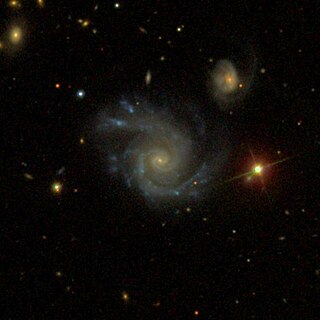
NGC 5829 is a spiral galaxy located in the constellation Boötes. It is 281 million light-years away from Earth and was discovered by astronomer, Edouard Stephan in May 1882.
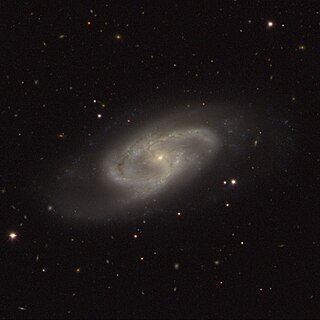
NGC 150 is a barred spiral galaxy in the constellation Sculptor. It is about 70 million light years away from the Solar System, and it has a diameter of about 55,000 light years. It was discovered on 20 November 1886, by Lewis A. Swift. The Type II supernova SN 1990K was detected in NGC 150, and was reported to be similar to SN 1987A.

NGC 1998 is a lenticular galaxy located in the Pictor constellation. It was discovered by John Herschel on December 28, 1834 and is about 207 million light-years from the Milky Way. Its apparent magnitude is 14.3. and its size is 0.90 by 0.5 arc minutes. In some sources such as SIMBAD, it is misidentified as nearby double star NGC 1995.

NGC 499, also occasionally referred to as PGC 5060, IC 1686 or GC 289, is a lenticular galaxy in the constellation Pisces. It is located approximately 197 million light-years from the Solar System and was discovered on 12 September, 1784 by astronomer William Herschel.

NGC 515, also occasionally referred to as PGC 5201 or UGC 956, is a lenticular galaxy located approximately 228 million light-years from the Solar System in the constellation Pisces. It was discovered on 13 September 1784 by astronomer William Herschel.

NGC 517, also occasionally referred to as PGC 5214 or UGC 960, is a lenticular galaxy located approximately 188 million light-years from the Solar System in the constellation Pisces. It was discovered on 13 September 1784 by astronomer William Herschel.

NGC 519, also occasionally referred to as PGC 5182, is an elliptical galaxy located approximately 242 million light-years from the Solar System in the constellation Cetus. It was discovered on 20 November 1886 by astronomer Lewis Swift.

NGC 521, also occasionally referred to as PGC 5190 or UGC 962, is a barred spiral galaxy located approximately 224 million light-years from the Solar System in the constellation Cetus. It was discovered on 8 October 1785 by astronomer William Herschel.
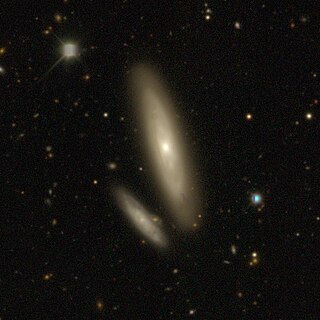
NGC 527, also occasionally referred to as PGC 5128 or PGC 5141, is a lenticular galaxy located approximately 259 million light-years from the Solar System in the constellation Sculptor. It was discovered on 1 September 1834 by astronomer John Herschel.
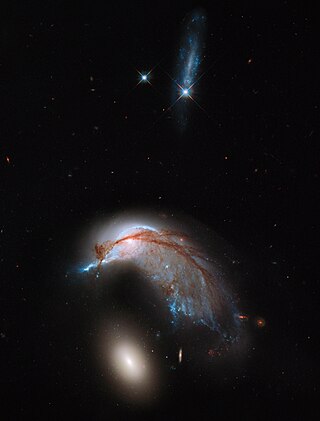
NGC 2936 is an interacting spiral galaxy located at a distance of 326 million light years, in the constellation Hydra. NGC 2936 is interacting with elliptical galaxy NGC 2937, located just beneath it. They were both discovered by Albert Marth on Mar 3, 1864. To some astronomers, the galaxy looks like a penguin or a porpoise. NGC 2936, NGC 2937, and PGC 1237172 are included in the Atlas of Peculiar Galaxies as Arp 142 in the category "Galaxy triplet".
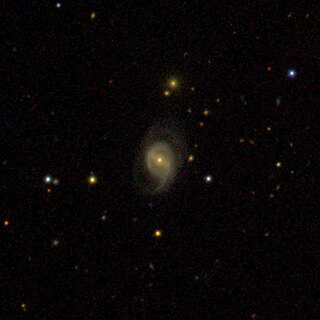
NGC 734 is a lenticular galaxy with a central bar in the constellation Cetus, which is about 538 million light years from the Milky Way. It was discovered on November 9, 1885, by the American astronomer Francis Preserved Leavenworth.

NGC 997 is an interacting galaxy in the constellation of Cetus. The galaxy was discovered by Albert Marth on 10 November 1863. It has a regularly rotating central molecular gas disk, containing a black hole of between 4 x 107 and 1.8 x 109 solar masses. Its speed relative to the cosmological background is 6,270 ± 45 km/s, corresponding to a Hubble distance of 92.5 ± 6.5 Mpc (~302 million ly).

NGC 5910 is an elliptical galaxy located about 540 million light-years away in the constellation Serpens. It was discovered by astronomer William Hershel on April 13, 1785. NGC 5910 is also a strong radio source with a conspicuous nuclear jet.

NGC 3110, known as NGC 3122 and NGC 3518 is an active spiral galaxy in the Constellation Sextans. It contains extensive Hubble-type Sb star-forming regions, and is located south of the celestial equator. It is estimated to be 218 million light-years from the Milky Way and has a diameter of around 100,000 ly. Together with PGC 29184 it forms a gravitationally bound galaxy pair. Located in the same area of the sky is the galaxy IC 589.
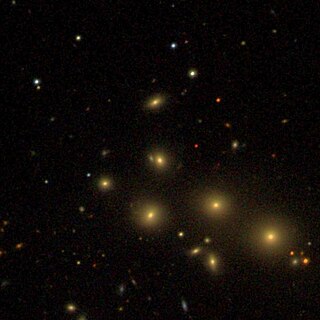
NGC 3647 is a small elliptical galaxy in the Leo constellation. The galaxy was first discovered on March 22, 1865 by Albert Marth who was a German astronomer. It is approximately 747 million light-years away. Due to its close proximity to five other elliptical galaxies, there was a bit of confusion for Marth to identify which object is NGC 3647.

NGC 5008 is a massive barred spiral galaxy located in the Boötes constellation.
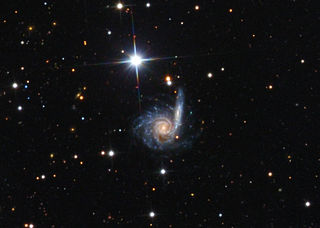
NGC 6365 is a pair of spiral galaxies in the constellation Draco. It consists of two galaxies, PGC 60174 to the south, and PGC 60171 to the north. These two galaxies are also designated respectively by the NASA/IPAC database as NGC 6365A and NGC 6365B. This pair of galaxies was discovered by German astronomer Lewis Swift in 1884.

NGC 5504 is an intermediate barred spiral galaxy located in the constellation Boötes. Its speed relative to the cosmic microwave background is 5,482 ± 17 km/s, which corresponds to a Hubble distance of 80.9 ± 5.7 Mpc. NGC 5504 was discovered by French astronomer Édouard Stephan in 1880.

NGC 633 is a large barred spiral galaxy located in the constellation Sculptor. Its speed relative to the cosmic microwave background is 4,979 ± 18 km/s, which corresponds to a Hubble distance of 73.4 ± 5.2 Mpc. NGC 633 was discovered by British astronomer John Herschel in 1834.



















